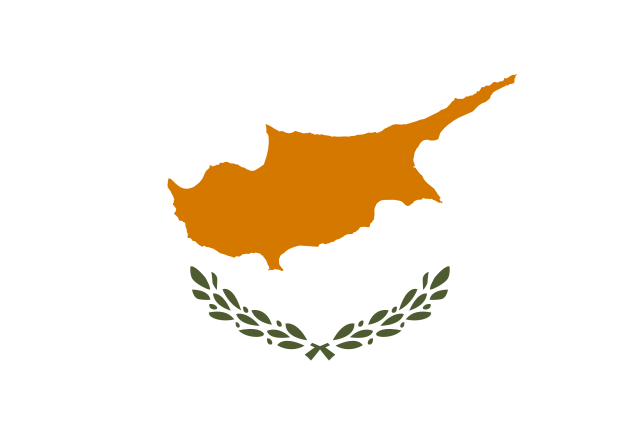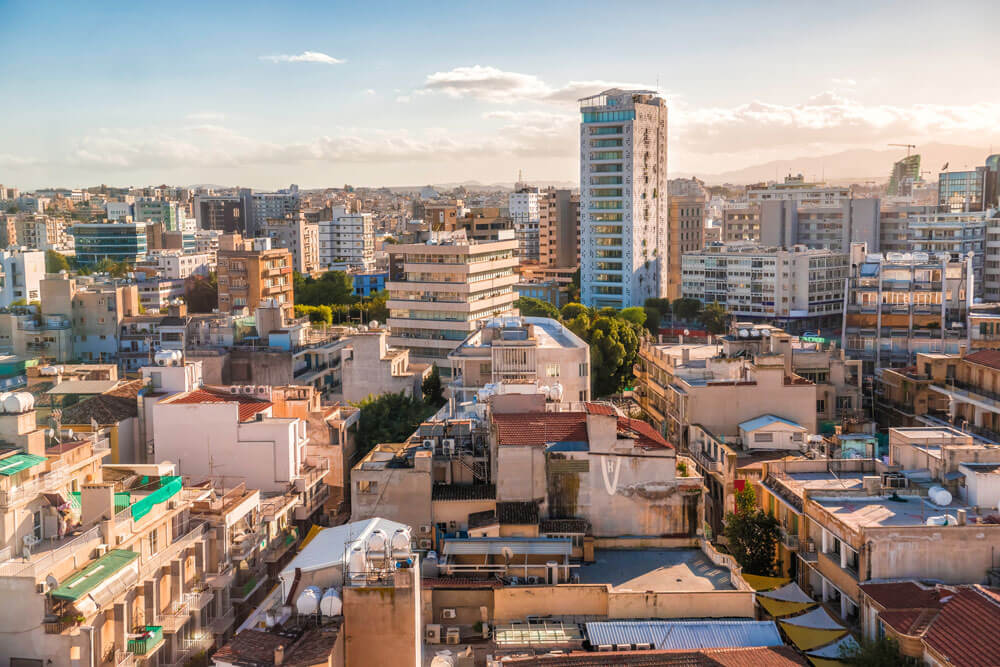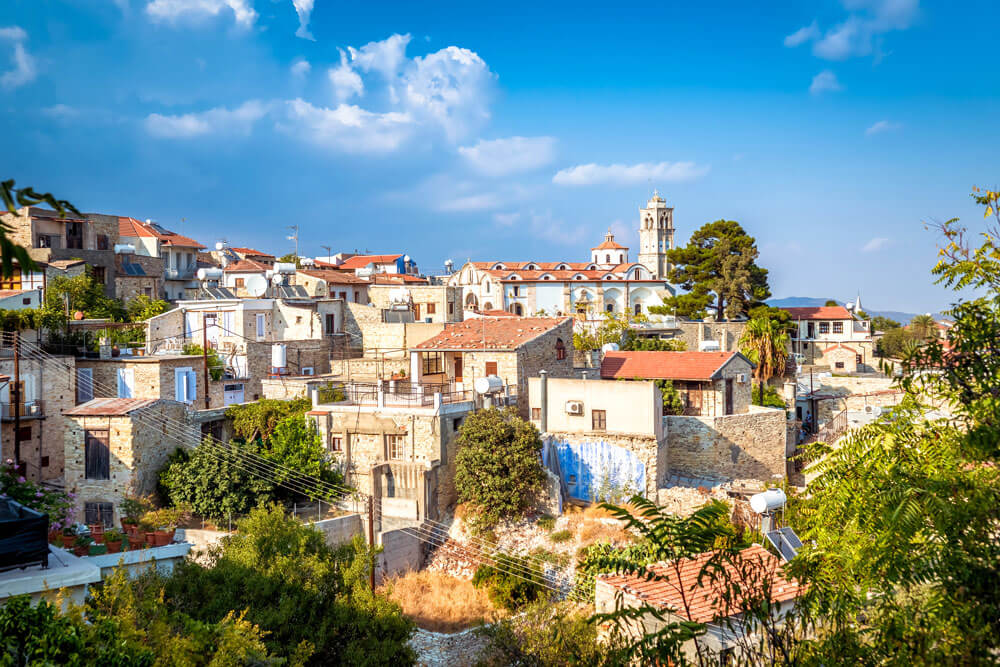Cyprus

Capital city: Nicosia
Population: 1,215,584 (2021)
Land area: 9,251 km²
Official languages: Greek, Turkish
Legal system: A mixed legal system including common law and continental tradition
Time zone: GMT+3
Currency: Euro
GDP: 23.50 USD Billion (2021 est.)
Main industries: Tourism, food and beverage processing, cement and gypsum, ship repair and refurbishment, textiles, light chemicals, metal products, wood, paper, stone and clay products
Principal exports: Citrus, potatoes, pharmaceuticals, cement, clothing
Located atop the eastern section of the Mediterranean Sea, at the junction between Europe, the Middle East and Africa, Cyprus is regionally the third largest island in size and population located about 80 km south of the coast of Turkey, west of Syria and Lebanon, northwest of Israel, north of Egypt and east of Greece. The nation has a significance in history due to its status as a cultural, linguistic and historical hub for the three regions it connects as well as for its stunning topography, abundance in natural resources and high quality produce. Cyprus is the sunniest country in Europe with over 300 days of sun annually.
The country is known for its unique geographical outline which to many resembles a saucepan like shape. The approximate 640 km length of its coastline mainly consists of long sandy beaches; to the south and southwest lie the Troodos Mountains which are part of the Alpine-Himalayan mountain belt and are famous for their geologically rich range of igneous rocks formed from the lava and molten foundation of the now-extinct sea of Tethys that separated the Eurasian and Afro-Arabian continents during the Mesozoic Era. The mountain range reaches all the way towards the southeastern coast where it ends at the range’s highest summit, Mount Olympus, which stands at a height of 6,401 feet. The northern coast of the island runs across 160 km of Cyprus’ northern and northeastern coastal line and the range is largely made of crystallised limestone and marble. The two mountain ranges are bisected in the middle by the central plain of Mesaoria which rises to an altitude of about 1,066 feet. The capital of the Republic of Cyprus, Nicosia, is located atop the plain along the Pedieos River.

Demographics
According to early 2022 estimates, Cyprus has a population of 1,295,102. 98.8% of the population is of Greek descent while the remaining 1% include Maronites, Armenians and Turkish Cypriots. The two official languages of Cyprus are Greek and Turkish which are spoken by 80.9% and 0.2% of the population, respectively. English is spoken by 4.1%, Romanian by 2.9%, Russian by 2.5%, Bulgarian by 2.2%, Arabic by 1.2% and Tagalog by 1.1%.
Approximately 90% of Cypriots are Orthodox Christians, 2.9% are Roman Catholics, 2.0% are Protestant/Anglican, 1.8% are Muslim, 1.0% are Buddhist, and 0.6% practice no religion/atheism. Two-thirds of the population lives in urban areas with a concentrated portion of the population dwelling in the capital city of Nicosia. Cyprus has a relatively young population with 28.0% under the age of 24 and 47.1% are of working age (between the age of 25 to 54).
History
The discovery of ancient tools and scorched animal bones in the rock shelter of Aetokremnos on the southern coast provide evidence of the earliest human settlement dating back 12,000 years ago. The first permanent and known settlement dates back to 9,000 years ago during the Neolithic Age in the town of Khirokitia, which is also located on the southern coast and has been marked as a World heritage Site by UNESCO since 1998. After a few centuries, the town along with other settlements disappeared and the island remained uninhabited for around 2,000 years. Evidence found in Sotira in the south and the Kyrenia Mountains in the north of Cyprus point to the next phase of settlement beginning in 4,500 BCE; the stone farmers on the island discovered and began to mine copper during the Bronze Age (3000-2500 BCE) and many pieces of decorative pottery have been discovered as well as imported materials from Syria, Egypt, Crete and Anatolia showcasing how trade with the Middle East had begun. Trade was bustling during the late Bronze Age (1600-1050 BCE) as Cypriot fine jewellery, ivory carvings and bronze figures became well-known overseas.
Greek immigration is said to have begun by 1200 BCE and the Greek language and culture became widespread as the immigrants built new cities, marking the beginning of a civilised society across a land of many towns and palaces. In 709 BCE, the King of Assyria, Sargon II, ordered a stela be built of his at Citium and until 669 BCE the Assyrian kingdom were paid tributes by Cypriot kingdoms. Cyprus was briefly under the influence of the Egyptian king and pharaoh, Ahmose II, based on limestone sculptures donning Egyptian garments and statues of Egyptian models, until 525 BCE when the kings of Cyprus shifted their loyalty to the Persians who conquered Egypt. They were incorporated into the Persian Empire in 522 BCE during the accession of Darius I and remained under Persian rule until Alexander the Great defeated Darius III, the last Achamenid rule, during the Battle of Issus in 333 BCE. Upon his death, Alexander’s generals fought for control over the conquered jurisdictions and Ptolemy I of Egypt emerged as the victor over Cyprus and subsequently brought the island under Egyptian rule as a province and administered the territory through a governor-general. Cyprus was conquered by the Roman Republic and became a Roman province in 58 BCE; it was briefly gifted to the Queen of Egypt Cleopatra VII by Julius Caesar around 40 BCE but was again brought under Roman rule in 31 BCE. 45 CE was a significant year during the Roman rule of Cyprus; the arrival of St Paul who was accompanied by St Barnabas, a member of the Cypriot Jewish community, who introduced Christianity to the island and converted the governor of the province at the time, Sergius Paulus.
When the Roman Empire split in 395 CE, Cyprus was assimilated into the Eastern division, the Byzantine Empire. Although it was brought under the Patriarchate of Antioch, the Church of Cyprus remained autocephalous. After 300 years of Byzantine rule, Cyprus began to be raided by Arabs. Subsequently, a treaty of neutralisation of the territory of Cyprus was signed between Justinian II of Byzantine and the Islamic Caliphate in 688 CE, though the treaty was constantly violated by both sides until emperor Nicephorus II Phocas of Byzantine took full control of the island in 965 CE. Though Cyprus continued to prosper under Byzantine rule, the latter’s gradual decline culminated in the territory being captured by King Richard I of England in 1191 CE who then later sold it to Frenchman Guy de Lusignan who then began a feudal monarchy on the island and remained ruler for the next three centuries. During this time, Venetian interest in the territory began to grow and a rivalry began to brew between Venice and Genoa over control of Cyprus. The last Lusignan king, James II, married a Venetian noblewoman, Caterina Cornaro, who succeeded him upon his death in 1473 CE and ceded Cyprus to the Republic of Venice. Cyprus remained under Venetian rule for 82 years.
Turkish forces usurped Nicosia in 1570 and a year later they seized Famagusta, paving the way for 300 years of Ottoman Rule over Cyprus.
Key dates in the history of Cyprus
1914 Cyprus annexed by Britain, after more than 300 years of Ottoman rule. Britain had occupied the island in 1878, although it remained nominally under Ottoman sovereignty.
1925 Cyprus comes under British administration as a colony
1955 The National Organisation of Cypriot Combatants (EOKA), wants enosis (unification) with Greece
1960 Britain grants independence to Cyprus under a power-sharing constitution between Turkish and Greek Cypriots
1983 Rauf Denktas declares a Turkish Republic of Northern Cyprus, recognised only by Turkey.
2003 Turkish and Greek Cypriots cross island’s dividing “green line” for first time in 30 years after Turkish Cypriot authorities ease border restrictions in April
2008 Cyprus officially adopts the euro

Legal System and Government
The Republic of Cyprus is a unitary presidential representative republic, whereby the President of Cyprus is both head of state and head of government. Executive power is exercised by the government. Legislative power is vested in both the government and the parliament. The Judiciary is independent of the executive and the legislature.
Cyprus is a common law jurisdiction, and its legal system is based on the adversarial model. Main sources of law include the Constitution of the Republic of Cyprus, the laws retained in force by virtue of Article 188 of the Constitution, the principles of Common Law and Equity, as well as the Laws enacted by the House of Representatives. Following Cyprus’ membership to the European Union in 2004, the Constitution was amended to give European law supremacy over the Constitution and national legislation.
Economy
The Cyprus economy is heavily reliant on services which account for 73.1% of GDP and 83.7% of the nation’s gross value added (GVA); tourism alone contributes 21% of the GDP. The industry sector of Cyprus, predominantly galvanised by the tourism, food processing, textiles, ship repair, light chemicals, wood, paper and stone and clay product industries contributes 12.83% of GDP. Although agriculture only provides 1.77% of the nation’s GDP, Cyprus is famous for its citrus fruits, potatoes, olives and halloumi amongst other niche products including pomegranates, prickly pears, carobs and aloe vera. The European Union is Cyprus’ largest, and most important, trading partner. It accounts for 50% of all Cypriot trade flows, followed by the Middle East.
The current employment rate in Cyprus is 72.7%, of which 81.7% are directly employed in the predominant services sector and 1.9% of the population works in the agriculture sector. As for the industries, approximately 6% of the workforce is employed in manufacturing and 7% work in public services and government administration. Cyprus’ score on the Index of Economic Freedom 2022 was 72.9, ranking it the 23rd freest economy in the world and 16th amongst the 45 nations of the European region.
Trade
In 2021 Cyprus gained US$27.7 billion in GDP. Top exports were ships, boats, and other floating structures (31.5 %), mineral fuels, oils, distillation products (19.5%), pharmaceutical products (10.6%), and dairy products, eggs, honey, edible products (8.2%). The main export partners were Lebanon (8.7%), Greece (7.7%), Marshall Islands (7.6%) and ship stores and bunkers (6.7%). Cyprus’ main import commodities were mineral fuels, oils, and distillation products (18.4%), ships, boats, and other floating structures (10.5%) vehicles other than railway and tramways (6.2%) and electrical machinery, equipment and parts thereof (5.9%). Main import suppliers were Greece (23.9%), Italy (10.2%), Germany (6.2%), and the Netherlands (5.1%).
Investment Opportunities
Cyprus is an ideal location for investment due to its strategic geographical location, stable business and political environment, low crime rates, skilled, youthful and highly educated workforce, advanced and efficient transportation and communication systems and scenic residences and distinguished hospitality sectors for a luxurious standard of living. Cyprus is offering pathways for citizenship that can be approved in as little as 4 months, leading to an EU nation citizenship and its consequent benefits. Cyprus is steadily growing to become the tech hub of the region as it already hosts many international tech companies and hefty investments, both foreign and local, have been directed to the Information and Communications Technology sectors to nurture growth and innovation; this has begun to show results particularly in the fields of software development. Cyprus recently also launched Project Bank, an online tool that matches investors with the market opportunities and projects compatible with the investors’ interests and objectives through an efficient and well-organised online system.
Cyprus has the potential to become a global fuel hub now with the discovery of high-grade hydrocarbons in its Exclusive Economic Zone (EEZ), which the state is capitalising on via the construction of the Cyprus LNG Terminal (a.k.a the Vassilikos) and the floating storage and regasification unit (FSRU). The construction of these facilities began in mid of last year, and once completed will decrease energy costs of the consumers within Cyprus, and due to the advantageous position of Cyprus at the cross section of Europe, the Middle East and the region of Maghreb, the possibilities for the energy market seem versatile and prosperous.
Being a member of the European Union, Cyprus enjoys favourable EU and OECD approved tax regimes. The corporate income tax rate stands at a low 12.5, and investors can take advantage of tax neutrality on foreign exchange differences, no taxation on capital gains, exit tax, no Controlled Foreign Currency (CFC) rules, and 50% exemption on employment income exceeding €100,000 per annum for non-residents taking up employment in Cyprus amongst many other benefits.